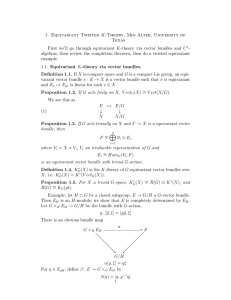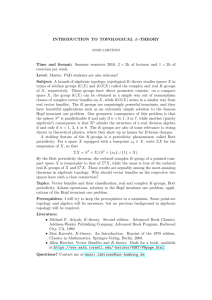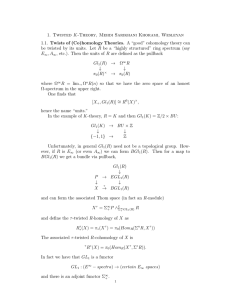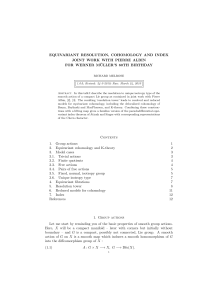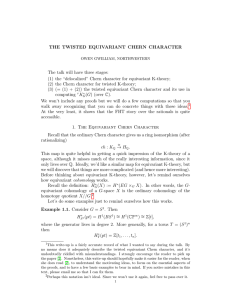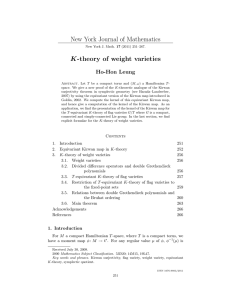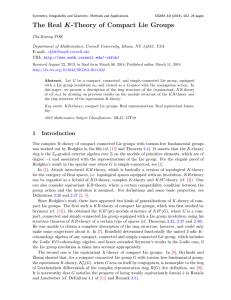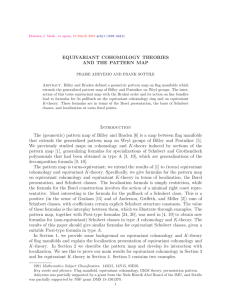Equivariant index and Chern character Richard B. Melrose ed´
advertisement
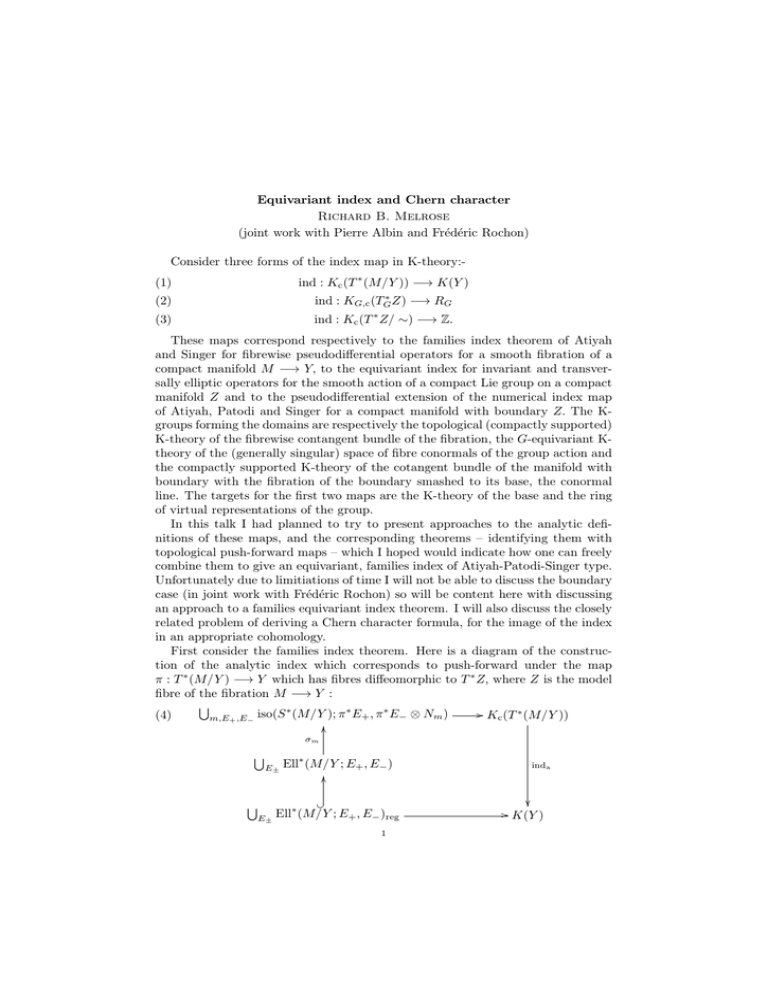
Equivariant index and Chern character Richard B. Melrose (joint work with Pierre Albin and Frédéric Rochon) Consider three forms of the index map in K-theory:(1) ind : Kc (T ∗ (M/Y )) −→ K(Y ) (2) ind : KG,c (TG∗ Z) −→ RG (3) ind : Kc (T ∗ Z/ ∼) −→ Z. These maps correspond respectively to the families index theorem of Atiyah and Singer for fibrewise pseudodifferential operators for a smooth fibration of a compact manifold M −→ Y, to the equivariant index for invariant and transversally elliptic operators for the smooth action of a compact Lie group on a compact manifold Z and to the pseudodifferential extension of the numerical index map of Atiyah, Patodi and Singer for a compact manifold with boundary Z. The Kgroups forming the domains are respectively the topological (compactly supported) K-theory of the fibrewise contangent bundle of the fibration, the G-equivariant Ktheory of the (generally singular) space of fibre conormals of the group action and the compactly supported K-theory of the cotangent bundle of the manifold with boundary with the fibration of the boundary smashed to its base, the conormal line. The targets for the first two maps are the K-theory of the base and the ring of virtual representations of the group. In this talk I had planned to try to present approaches to the analytic definitions of these maps, and the corresponding theorems – identifying them with topological push-forward maps – which I hoped would indicate how one can freely combine them to give an equivariant, families index of Atiyah-Patodi-Singer type. Unfortunately due to limitiations of time I will not be able to discuss the boundary case (in joint work with Frédéric Rochon) so will be content here with discussing an approach to a families equivariant index theorem. I will also discuss the closely related problem of deriving a Chern character formula, for the image of the index in an appropriate cohomology. First consider the families index theorem. Here is a diagram of the construction of the analytic index which corresponds to push-forward under the map π : T ∗ (M/Y ) −→ Y which has fibres diffeomorphic to T ∗ Z, where Z is the model fibre of the fibration M −→ Y : S ∗ ∗ ∗ / Kc (T ∗ (M/Y )) (4) m,E+ ,E− iso(S (M/Y ); π E+ , π E− ⊗ Nm ) O σm S S E± E± Ell∗ (M/Y ; E+ , E− ) O ? Ell∗ (M/Y ; E+ , E− )reg 1 inda / K(Y ) The ‘regular’ elliptic families are those with null spaces of constant dimension. The ‘model’ for Kc (T ∗ (M/Y )) is pairs of vector bundles over the base of the radial compactification, T ∗ (M/Y ) ⊃ T ∗ (M/Y ), of the fibrewise cotangent bundle with an identification (the symbol of the operator) between them over the boundary (the sphere at infinity). There is a semiclassical version of the index based on a different model for K-theory. Namely for a compact manifold with boundary, X, the compactlysupported K-theory of the interior can be realized as equivalence classes of projectionvalued maps (idempotents) γ : X −→ M (N, C), γ 2 = γ, which are constant in Taylor series at the boundary γ ≡ γ0 ∈ M (N, C) at ∂X. Here X = T ∗ (M/Y ) ⊃ T ∗ (M/Y ). The algebra of semiclassical pseudodifferential operators has both a ‘usual’ and a semiclassical symbol map (5) Ψ0 (M/Y ; CN ) σsl / C ∞ (X; M (N, C)) and this allows one to construct the diagram (6) S ∞ 2 N γ ∈ C (X; M (N, C)), γ = γ ≡ γ0 at ∂X, γ0 ∈ M (N, C) O XXXXX XXXXX XXXXX XXXXX XX+ σsl Kc (T ∗ (M/Y )) indsl K(Y ) 3 f f ffff f f f f fffff fffff f f f f ff S N 2 0 N Γ ∈ Ψsl (M/Y ; C ), Γ = Γ, σsl (Γ) ∈ M (N, C) That (7) inda = indsl = indt follows by showing that the two representations of the K-theory of the relative cotangent bundle discussed above are each the retraction of a larger model which can be directly quantized using similar constructions but of Toeplitz type. The right-hand inequality is then a reorganization of the proof given by Atiyah and Singer but in place of an axiomatic discussion one can simply follow the semiclassical quantization through the definition of the topological index by embedding. This approach to the index theorem is used in a twisted setting in [2] and a more detailed discussion can be found in [3]. The G-equivariant case arises from the smooth action of a compact group on a compact manifold Z, which gives a smooth homomorphism of the group into the diffeomorphisms of the manifold. The complexity of this setting arises from the variability of the isotropy groups, the subgroups which fix particular points. Again there is a semiclassical realization of the index map, now (2), analgous to that 2 above. Indeed in on-going work with Pierre Albin a families equivariant index will be discussed. This arises from a fibration M −→ Y where M and Y are compact G-manifolds and the fibration is equivariant. Then the families-equivariant index map induces the push-forward (8) Kc,G (TG∗ (M/Y )) −→ K̂G (Y ) into an appropriately completed equivariant K-theory of the base. The resolution of group actions, to have fixed isotropy type, in recent work with Albin, allows the delocalized equivariant cohomology of Baum, Brylinski and MacPherson [1] to be extended to the non-Abelian case and to be given a deRham realization (on the resolution of the quotient). This in turn should allow explicit Chern character formulæ to be developed in this more general context – and ultimately in the (here unexplained) boundary case as well. References [1] Paul Baum, Jean-Luc Brylinski, and Robert MacPherson, Cohomologie équivariante délocalisée, C. R. Acad. Sci. Paris Sér. I Math. 300 (1985), no. 17, 605–608. MR 86g:55006 [2] V. Mathai, R.B. Melrose, and I.M. Singer, The index of projective families of elliptic operators: The decomposable case, Arxiv:0809.0028. [3] Richard B. Melrose, Topics in analysis: Smooth operator algebras and k-theory, Notes at Berkeley, 2008. 3
